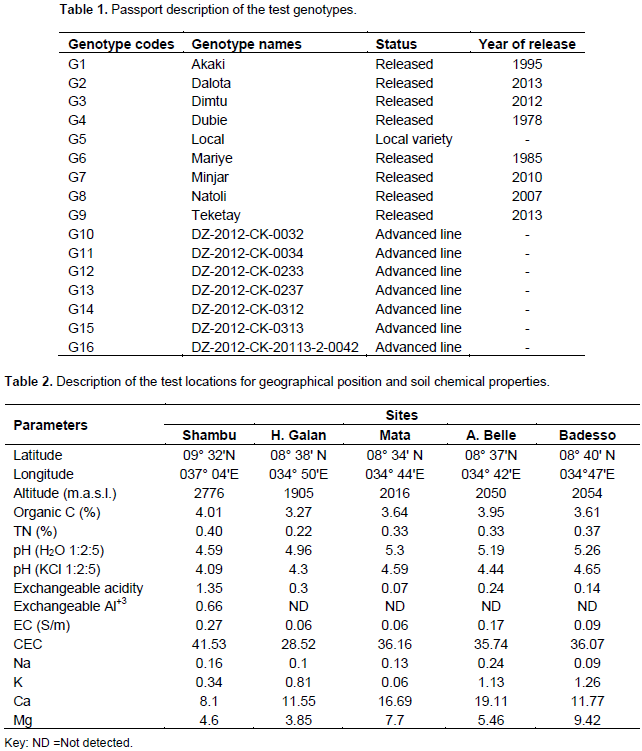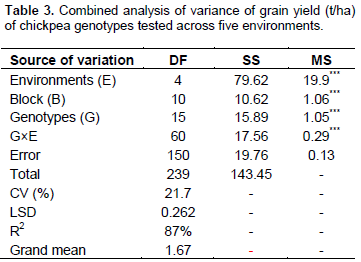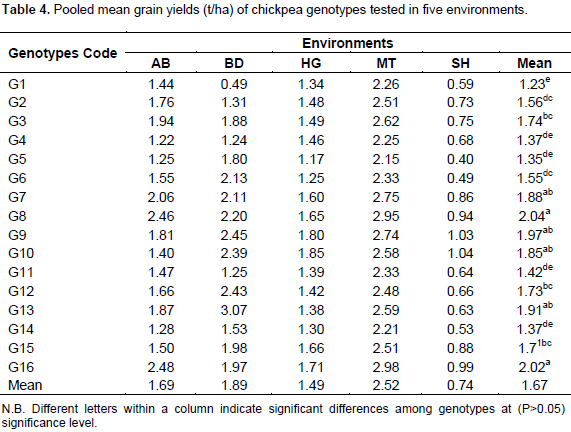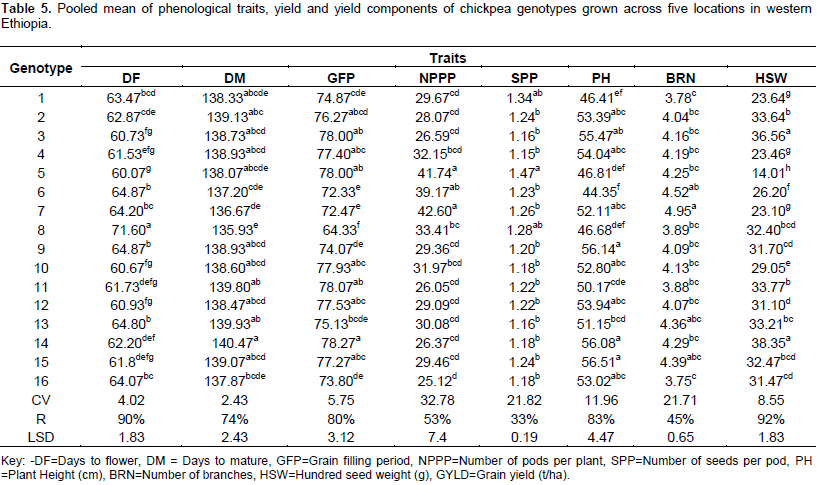ABSTRACT
Currently, 40% of arable land in Ethiopia is affected by acidity and particularly the soil acidity problem that occurs in central and western zones of Oromia deserves immediate intervention for crop production. The objective of the present study was to examine responses of Desi type chickpea varieties against acidic soil of western Ethiopia. Pooled analysis of variance (ANOVA) indicated significant difference among genotypes indicating differential response of chickpea genotypes to acidic soil. The combined mean of genotypes indicates that Natoli and DZ-2012-CK-20113-2-0042 were top yielders. Differential response of chickpea genotypes indicates the possibilities of designing better chickpea breeding strategies that aim at screening large germplasms of chickpea genotypes for soil acidity tolerance and thereby developing a cultivar(s) with wider adaptations.
Key words: Chickpea (Cicer arietinum L.), yield, soil acidity, liming.
Pulses play a significant role in sustaining food security, balancing ecosystem, and generating revenue in Ethiopia. Chickpea (Cicer arietinum L.) is the most important food legumes grown in Ethiopia. Although the ecological and economic contribution of chickpea is high, its productivity is by far below its potential because of the several biophysical and socioeconomic constraints in Ethiopia (Keneni et al., 2012). Biotic and abiotic stresses cause significant economic losses to this crop (Datta et al., 2008). Among these factors, abiotic stresses due to soil acidity were one of the major factors that hamper chickpea productivity with worldwide distribution. Acidic soils limit crop production on 30-40% of the world's arable land and up to 70% of the world's potentially arable land. In Ethiopia 40% of arable land is currently affected by acidity and particularly the soil acidity problem that occurs in central and western zones of Oromia deserves immediate intervention and amelioration for crop production (Batjes, 1995; Abdenna et al., 2007; Abebe, 2007). Soil pH is probably the most important principal chemical soil parameter and it mirrors the overall chemical status of the soil and influences a whole range of chemical and biological processes occurring in the soils. Most plants and soil organisms prefer pH range between 6.0 and 7.5 (Hazelton and Murphy, 2007; Hall, 2008). Different scholars reported the pH of the soils in western Ethiopia is in acidic range and it needs immediate intervention and ameliorations for crop production (Chimdi et al., 2012; Deressa et al., 2013). Under such low pH, the availability of essential nutrients is critically affected. Moreover, the activities of microorganisms, which play pivotal roles in nutrient cycling in agro ecosystems, are affected (Addisu, 2007). Several strategies have been pursued to manage acid soils including an application of lime (calcium carbonate) to raise soil pH to less toxic forms. Nevertheless, because of a topographic feature of the lands, affordability and logistics reasons, application of lime is not practicable for resource-poor farmers. Furthermore, soil pH below plow layer is raised very slowly by liming (Dall'Agnol et al., 1996). Consequently, these reasons direct a need of developing cultivars that are adapted to acid soil complexes as a promising alternative for resource-poor farmers. Therefore, morphological characterization of plants that better tolerate acidity under the usual condition and give rise better yield and economic turn for poor farmers is a promising alternative to liming and related agronomic practices. The present study was, therefore, conducted with the objective of examining the responses of Desi type chickpea genotypes against the acidic soils of western Ethiopia.
Plant material and site description
Field experiment was conducted at five locations viz., Shambu, Hawa Galan, Mata, Alaku Belle and Badesso, Western Ethiopia, during the 2016/2017 main cropping season. A total of 16 Desi type chickpea varieties viz., 8 cultivars released over three decades, 1 local variety and 7 advanced lines introduced from Debre Zeit Agricultural Research Center (DZARC) were used (Table 1). The experiment was laid out in a randomized complete block design (RCBD) with three replicates. The plot size was six rows of three-meter length (5.4 m2). The central four rows were harvested to determine seed yield. Diammonium phosphate fertilizer (DAP) with a rate of 100 kg/ha was used and all other crop management and protection practices were applied uniformly as recommended. Soil samples were collected and composited from each of the experimental sites at the depth of 0 to 20 cm using an auger to analyze the chemical properties of the soil. Description of the test locations for geographical position and the chemical properties of the soils in the study area are presented (Table 2).

Data collection and statistical analysis
Days to 50% flowering, days to 90% maturity, grain filling duration, number of pods per plant, number of seeds per pod, plant height, number of branches per plant, hundred seed weight, and grain yield data were collected based on chickpea (Cicer arietinum L.) descriptor (IBPGR, ICRISAT and ICARDA, 1993) and were subjected to analysis using statistical analysis software (SAS Inc., 2003).
Analysis of variance
Pooled analysis of variance indicated highly significant differences for genotypes, environments and genotype × environment interaction (G×E). Variance component of sum squares were 55% for environments, 11% for genotypes and 12% for G×E. This indicated that environmental factors played a leading role for the variability observed among chickpea genotypes in western Ethiopia. In addition to the environmental factors, the contribution of G×E was also appreciable. The significant G×E suggests that grain yield of chickpea genotypes varied across environmental conditions (Table 3).

Yield performance
The mean grain yield of the sixteen genotypes tested at five environments of Western Ethiopia indicated statistically significant difference among genotypes. At Alaku Belle, genotype DZ-2012-CK-20113-2-0042 and Natoli were better performers while Dubie was the worst performer where the best performer genotypes exceeded it by more than two-fold. At Badesso, genotype DZ-2012-CK-0237 performed better than any other genotype and Akaki was found to be the poorest of all at this location. At Hawa Galan and Shambu, genotype DZ-2012-CK-0032 out-performed the other genotypes while local variety was the poorest performer at both the locations. At Mata, genotype, DZ-2012-CK-20113-2-0042 was the best performer as in Alaku Belle and the performance of the local variety was the poorest in a similar fashion it displayed in Shambu and Hawa Galan (Table 4). This result is in agreement with the report of Getachew et al. (2015) who showed inconsistent performances of chickpea genotypes in central and eastern Ethiopia. Tolessa (2015) conducted multi-locational studies of seventeen Faba bean varieties and reported that the varieties responded differentially in southeastern and central Oromia. Similar result was noted on sesame in northern Ethiopia (Tadesse and Abay, 2011). The combined mean of genotypes indicates that Natoli and DZ-2012-CK-20113-2-0042 were top yielders though they did not differ in a statistically significant manner from Minjar, Teketay, DZ-2012-CK-0032, and DZ-2012-CK-0237 (Table 4).

Agronomic performance
Differences among the genotypes were significant for a number of characters (Table 5). A local variety included in this investigation flower early (60) and relatively mature intermediary. This indicated that local landraces had a relatively longer grain filling period.Similarly, Summerfield and Roberts (1988) reported early flowering genotypes do not certainly mature early and some late flowering genotypes have a short reproductive period and mature concurrently with earlier flowering ones. Wakeyo (2012) also tested 155 chickpea germplasms including landraces, improved varieties and some introduced pipelines indicating that landraces had a relatively shorter period of vegetative growth and longer grain filling periods. Except DZ-2012-CK-0032 and DZ-2012-CK-0233, all other advanced lines and improved varieties included within this study showed delayed flowering. This might be due to higher asset they employ at vegetative growth. In contrast to this, though Natoli was late to flower (71.60); it pays its late flower by filling the grain as short as possible (64.3). Mariye (72.33), Minjar (72.47), DZ-2012-CK-20113-2-0042 (73.80) and Teketay (74.07) were also acquired a short grain filling period, whereas DZ-2012-CK-0312 was the late maturing genotype with accompanied long grain filling period (78.27). Minjar, Mariye and local landrace developed relatively higher number pods than other genotypes. Even though improved genotypes display small difference among themselves for seeds per pod; the difference with landraces was very high. On the other hand, in terms of plant height, Mariye, Akaki, Natoli and local landraces were the shortest, whereas DZ-2012-CK-0313, Teketay, DZ-2012-CK-0312, Dubie and Dimtu were comparatively taller genotypes. Nevertheless, the pod bearing character of the local landrace, Natoli, Mariye and Minjar may not emanate from their branches. The local landraces included in this study were by far inferior by their seed weight. Wakeyo (2012) also reported that the seed size of landraces was not comparable to improved genotypes and released varieties. However, among released and advanced genotypes there were differential seed weights. Some of the released varieties namely Akaki, Dubie and Minjar also possess small seed weights. In the contrary, DZ-2012-CK-0312 and Dimtu showed higher seed weight than all the tested materials. Overall, Natoli, Minjar, Teketay, DZ-2012-CK-0032, DZ-2012-CK-0237 and DZ-2012-CK-20113-2-0042 were the best performing genotypes. Akaki, a variety released two decades ago, was the poorest performing variety across all test environments, followed by Dubie, Local variety, DZ-2012-CK-0034 and DZ-2012-CK-0312 (Table 5).

This study revealed that chickpea genotypes differ in tolerance to soil acidity. Although some genotypes exhibited an outstanding performance in terms of grain yield and yield related traits, soil fertility improvement through lime application would still be very important if economical chickpea production is to be practiced in places with strong acid soil as the one used in this study and other similar growing environments. Generally, differential response of chickpea genotypes indicates thepossibilities of designing better chickpea breeding strategies that aim at screening large germplasm of chickpea for soil acidity tolerance and thereby developing a cultivar(s) with wider adaptations.
The authors have not declared any conflict of interests.
REFERENCES
|
Abdenna D, Negassa CW, Tilahun G (2007). Inventory of soil acidity status. In: Crop Lands of Central and Western Ethiopia: Utilizations of diversity in land use systems: Sustainable and organic approaches to meet human needs.
View
|
|
|
|
Abebe M (2007). Nature and management of acid soils in Ethiopia. Ethiopian Institute of Agricultural Research, Addis Ababa, Ethiopia.
View
|
|
|
|
Addisu M (2007). Abundance and diversity of top soil earthworms in relation to chemical use in golden rose agro farm, Tefki area, Ethiopia (MSc thesis, Addis Ababa University)
|
|
|
|
Batjes NH (1995). A homogenized soil data file for global environmental research: A subset of FAO, ISRIC and NRCS profiles (Version 1.0) (No. 95/10b, p. 43). ISRIC.
|
|
|
|
Chimdi A, Gebrekidan H, Kibret K, Tadesse A (2012). Effects of liming on acidity-related chemical properties of soils of different land use systems in Western Oromia, Ethiopia. World J. Agric. Sci. 8(6):560-567.
|
|
|
|
Dall'Agnol M, Bouton JH, Parrott WA (1996). Screening methods to develop alfalfa germplasms tolerant of acid, aluminum toxic soils. Crop Sci. 36(1):64-70.
Crossref
|
|
|
|
Datta A, Sindel BM, Kristiansen P, Jessop RS, Felton WL (2008). The effect of soil pH on chickpea (Cicer arietinum L.) genotype sensitivity to isoxaflutole. Plant Soil 303(12):49-54.
Crossref
|
|
|
|
Deressa A, Bote B, Legesse H (2013). Evaluation of soil cations in agricultural soils of East Wollega Zone in South Western Ethiopia. Sci. Technol. Arts Res. J. 2(1):10-17.
Crossref
|
|
|
|
Getachew T, Firew M, Asnake F, Million E (2015). Genotype x environment interaction and stability analysis for yield and yield related traits of Kabuli-type Chickpea (Cicer arietinum L.) in Ethiopia. Afr. J Biotechnol. 14(18):1564-1575.
Crossref
|
|
|
|
Hall R (2008). Soil Essentials: Managing Your Farm's Primary Asset. Land links Press. 192p.
|
|
|
|
Hazelton P, Murphy B (2016). Interpreting soil test results: what do all the numbers mean? CSIRO publishing. 200p.
|
|
|
|
IBPGR, ICRISAT, ICARDA (1993). Descriptors for Chickpea (Cicer arietinum L.). International Board for Plant Genetic Resources, Rome, Italy; International Crops Research Institute for the Semi-Arid Tropics, Patancheru, India. International Center for Agricultural Research in the Dry Areas, Aleppo, Syria.
|
|
|
|
Keneni G, Bekele E, Imtiaz M, Dagne K, Getu E, Assefa F (2012). Genetic Diversity and Population Structure of Ethiopian Chickpea (Cicer arietinum L.) Germplasm Accessions from Different Geographical Origins as Revealed by Microsatellite Markers. Plant Mol. Biol. Reporter 30(3):654-665.
Crossref
|
|
|
|
SAS Institute (2003). SAS computer Program, version 9.0 edition. Cary, NC: SAS Institute Inc.
|
|
|
|
Summerfield RJ, Roberts EH (1988). Photo-thermal regulation of flowering in pea, lentil, faba bean and chickpea. In World Crops: Cool season food legumes. Springer Netherlands. pp. 911-922
Crossref
|
|
|
|
Tadesse H, Abay F (2011). Additive Main Effects and Multiplicative Interactions Analysis of yield Performance of sesame genotypes across environments in Northern Ethiopia. J. Drylands 4:259-266.
|
|
|
|
Tolessa T (2015). Application of AMMI and Tai's stability statistics for yield stability analysis in faba bean (Vicia faba L.) cultivars grown in Central Highlands of Ethiopia. J. Plant Sci. 3(4):197-206.
|
|
|
|
Wakeyo GK (2012). Genetic potential and limitations of Ethiopian chickpea (cicer arietinum L.) Germplasm for improving attributes of symbiotic nitrogen fixation, phosphorus uptake and use efficiency, and adzuki bean beetle (Callosobruchus chinensis L.) Resistance (Doctoral Dissertation, Addis Ababa University).
|